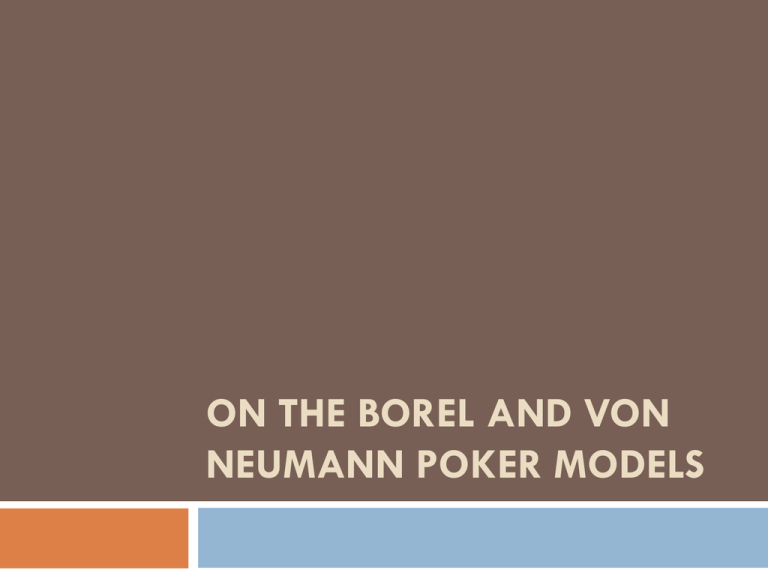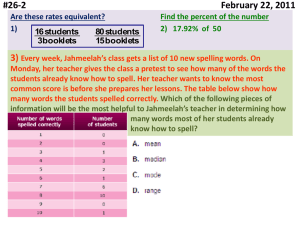
ON THE BOREL AND VON
NEUMANN POKER MODELS
Comparison with Real Poker
Real Poker:
Around
2.6 million possible hands for 5 card stud
Hands somewhat independent for Texas Hold ‘em
Let’s assume probability of hands comes from a
uniform distribution in [0,1]
Assume probabilities are independent
The Poker Models
La Relance Rules:
Each
player puts in 1 ante before seeing his number
Each player then sees his/her number
Player 1 chooses to bet B/fold
Player 2 chooses to call/fold
Whoever has the largest number wins.
von Neumann Rules:
Player
1 chooses to bet B/check immediately
Everything else same as La Relance
The Poker Models
http://www.cs.virginia.edu/~mky7b/cs6501poker/
rng.html
La Relance
Who has the edge, P1 or P2? Why?
Betting tree:
La Relance
The optimal strategy and value of the game:
Consider
the optimal strategy for player 2 first. It’s no
reason for player 2 to bluff/slow roll.
Assume
the optimal strategy for player 2 is:
Bet
when Y>c
Fold when Y<c
Nash’s
Equilibrium
La Relance
P2 should choose appropriate c so that P1’s decision
does not affect P2:
If PI has some hand X<c, the decision he makes should
not affect the game’s outcome.
Suppose PI bets B
P1 wins 1 if P2 has Y<c (since he folds ‘optimally’)
P1 loses B+1 if P2 has Y>c (since he calls ‘optimally’)
Suppose P1 folds
P1 wins -1
𝑐 − 𝐵 + 1 1 − 𝑐 = −1
Which yields:
𝑐 = 𝐵/(𝐵 + 2)
La Relance
We knew the optimal strategy for P2 is to always bet
when Y>c. Assume the optimal strategy for player I is:
Bet when X>c (No reason to fold when X>c since P2 always
folds when Y<c)
Bet with a certain probability p when X<c (Bluff)
Now PI should choose p so that P2’s decision is
indifferent:
𝑝 ≝ 𝑃(𝑃1 𝑏𝑒𝑡𝑠|𝑋 < 𝑐)
Using Bayes’ theorem:
𝑐𝑝
𝑃 𝑋 < 𝑐 𝑃1 𝑏𝑒𝑡𝑠 =
𝑐𝑝 + (1 − 𝑐)
La Relance
Consider P2’s Decision at Y=c:
If
P2 calls with Y=c, he/she wins pot if X<c and loses if
X>c:
𝑉𝑎𝑙𝑢𝑒 𝑃2 = 𝐵 + 1 × 𝑃 𝑋 < 𝑐 𝑃1 𝑏𝑒𝑡𝑠 − 𝑃(𝑋 > 𝑐|𝑃1 𝑏𝑒𝑡𝑠)
If
P2 folds, Value for P2 is -1.
Solve the equation:
𝐵 + 1 × 𝑃 𝑋 < 𝑐 𝑃1 𝑏𝑒𝑡𝑠 − 𝑃(𝑋 > 𝑐|𝑃1 𝑏𝑒𝑡𝑠) = −1
We get:
𝑝 = 1 − 𝑐 = 2/(𝐵 + 2)
La Relance
Now we can compute the value of the game as we
did in AKQ game:
𝑉𝑃1
𝐵2
𝐵 =−
(𝐵 + 2)2
Result shows the game favors P2.
La Relance
When to bluff if P1 gets a number X<c?
P1 bluffs with c2<X<c, (best hand not
betting), bets with X>c and folds with X<c2.
Why?
Intuitively,
If
P2 is playing with the optimal strategy, how to choose
when to bluff is not relevant.
This penalizes when P2 is not following the optimal strategy.
La Relance
What if player / opponent is suboptimal?
Assumed Strategy
player
1 should always bet if X > m, fold otherwise
player 2 should always call if Y > n, fold otherwise,
Also call if n > m is known (why?)
Assume decisions are not random beyond cards
dealt
Alternate Derivations Follow
La Relance
La Relance (Player 2 strategy)
La Relance (Player 2 strategy)
What can you infer from the properties of this
function?
What if m ≈ 0? What if m ≈ 1?
La Relance (Player 1 response)
Player 1 does not have a good response strategy
(why?)
La Relance (Player 1 Strategy)
Let’s assume player 2 doesn’t always bet when n >
m
This function is always increasing, is zero at n = β /
(β + 2)
What
should player 1 do?
La Relance (Player 1 Strategy)
If n is large enough, P1 should always bet (why?)
If n is small however, bet when m >
What if n = β / (β + 2) exactly?
Von Neumann
Betting tree:
Von Neumann
Von Neumann
Since P1 can check,
now
he gets positive value out of the game
P1 now bluff with the worst hand. Why?
On
the bluff part, it’s irrelevant to choose which section of
(0,a) to use if P2 calls (P2 calls only when Y>c)
On the check part, it’s relevant because results are
compared right away.
Von Neumann
Nash’s equilibrium:
Three key points:
P1’s view: P2 should be indifferent between folding/calling
with a hand of Y=c
𝐵 + 1 𝑎 − (𝐵 + 1) 1 − 𝑏 = −1
P2’s view: P1 should be indifferent between checking and
betting with X=a
𝑐− 𝐵+1 1−𝑐 =𝑎
P2’s view: P1 should be indifferent between checking and
betting with X=b
𝑐+ 𝐵+1 𝑏−𝑐 − 𝐵+1 1−𝑏 =𝑏
Von Neumann
What if player / opponent is suboptimal?
Assumed Strategy
Player
1 Bet if X < a or X > b, Check otherwise
Player 2 Call if Y > c, fold otherwise
If c is known, Player 1 wants to keep a < c and b > c
Von Neumann
Von Neumann
Von Neumann (Player 1 Strategy)
Find the maximum of the payoff function
a=
b=
What can we conclude here?
Von Neumann (Player 2 Response)
Player 2 does not have a good response strategy
Von Neumann (Player 2 Strategy)
This analysis is very similar to Borel Poker’s player 1
strategy, won’t go in depth here…
c=
Bellman & Blackwell
Bet tree
Where 0 ≤ 𝐵1 ≤ 𝐵2
Borel: B1= B2
Von Neumann: B1= 0
Bellman & Blackwell
mL
Fold
mH
Low B
b1
High B
b3
Low B
b2
High B
Bellman & Blackwell
Or
if
Where
La Relance: Non-identical Distribution
Still follows the similar pattern
Where F and G are distributions of P1 and P2, c is
still the threshold point for P2. π is still the
probability that P1 bets when he has X<c.
What if
?
La Relance:
(negative) Dependent hands
X and Y conforms to FGM distribution
Marginal distributions are still uniform.
𝜃 is correlation factor. 𝜃 < 0 means negative
correlation.
La Relance:
(negative) Dependent hands
Player 1 bets when X > l
P(Y
< c | X = l) = B / (B + 2)
Player 2 bets when Y > c
(2*B
+ 2)*P(X > c|Y = c) = (B + 2)*P(X > l|Y = c)
Game Value:
P(X
> Y) – P(Y < X)
+ B * [ P(c < Y < X) – P(l < X < Y AND Y > c) ]
+ 2 * [ P(X < Y < c AND X > l) – P(Y < X < l) ]
Von Neumann:
Non-identical Distribution
Also similar to before (just substitute the distribution
functions)
a
| (B + 2) * G(c) = 2 * G(a) + B
b | 2 * G(b) = G(c) + 1
c | (B + 2) * F(a) = B * (1 – F(b))
Von Neumann:
(negative) Dependent hands
Player 2 Optimal Strategy:
Player 1 Optimal Strategy:
Discussion / Thoughts / Questions
Is this a good model for poker?







